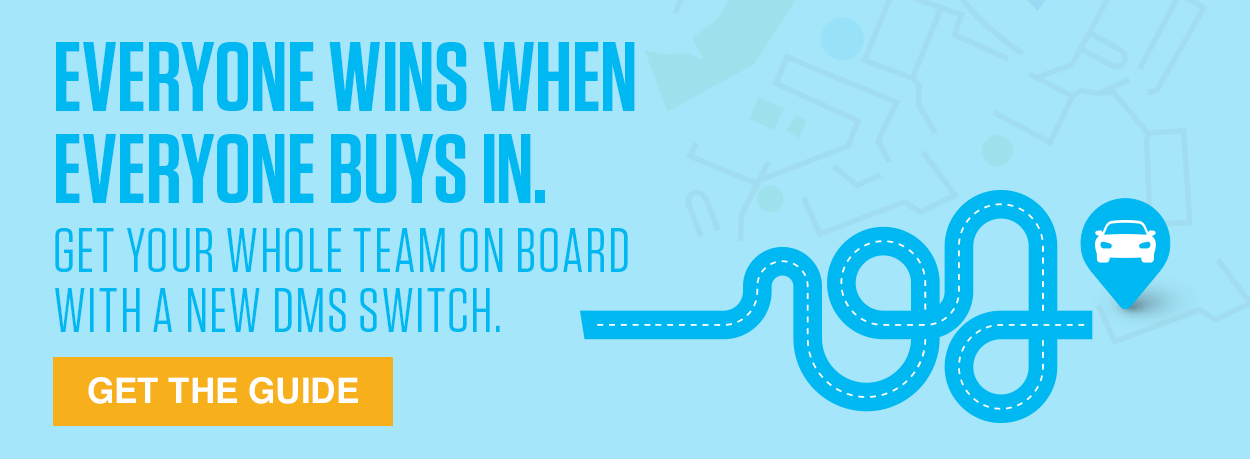Dreaming of investing in new technology to give your dealership that next-level boost over the competition? Many dealers get sold on fancy technology promises but lose sight of their goals and business needs in the process. Finding a new DMS partner is a big decision. But you can break it down into smaller, more manageable steps with the advice of Cox Automotive’s Director of Product Consulting, Josh Bickerton. Learn how to Invest in a Strategy to Overcome Inertia below and watch the full webinar to Demystify a DMS Switch when you’re ready.
 Understand Your Dealership
Understand Your Dealership
Understanding your own dealership goes beyond the day-to-day workflows. If you’re not taking a close look at your mission statement and what sets you apart from the competition, you’re at risk of losing sight of your core values in the overwhelming decision-making process. Start here, otherwise, you’re at risk of letting technology own the decision you’re about to make.
 Document Your Objectives
Document Your Objectives
Fear of change can derail even the best decisions. Make sure to stay aligned as a team by writing down how well a potential provider addresses your wants and needs. Catalog each department’s unique challenges to ensure you have a clear line of sight into the issues you hope to address by a technology switch
 Identify Employee Needs
Identify Employee Needs
Don’t ignore the fact that a new DMS will impact your current and future team members. Millennials and Gen Z now make up a significant portion of your workforce. According to a
report from cloud networking firm, HPE Aruba, 93% of surveyed employees believed their workplace would be better if their employer made greater use of technology, and 64% believed their companies will be left behind if they didn’t implement new technology. *
 Overcome the Fear of Change
Overcome the Fear of Change
The natural reaction to risk is to stick with the status quo. The ‘unknown’ can be perceived as threatening and switching to a new DMS can make even the most experienced employee feel like a novice again. Will your paycheck suffer? Will there be a negative impact on the business? Investing time and effort in learning a new system (or training new employees due to turnover) is also a common fear. Will my support staff assist with the change, and could we lose our data? It would be a mistake to ignore these very real, very common fears. Leaders and decision-makers need to address and acknowledge the anxiety that comes with any technology change.
 Set Expectations
Set Expectations
Knowing that no software change will be a perfect fit is not only realistic; it is also the antidote to the fear of change. When your staff understands that there will be grace given for a learning period due to change, and expectations are managed, some of the anxiety will be released.
 Expectations of Accountability
Expectations of Accountability
Have an agreement with your team that evaluating your new technology will be given a wholehearted effort. While many software companies may try to earn your business with shiny bells and whistles, you and your team will do your best to put in the discovery work and find a solution that meets your unique business needs.
 Validate your Contract End Date (CED)
Validate your Contract End Date (CED)
Before you make the decision to switch (or put the fear of change on the table) take a good look at your DMS vendor contract to fully understand when your contract ends. If you have ongoing 3rd-party vendor agreements, be sure to evaluate those as well.
Making a DMS switch impacts your whole dealership. From the data you use to deliver premium customer experiences, to running payroll, your DMS is the backbone of your entire business operation. But finding the right partner can empower your franchise to profitability once you’ve made the move. While it may seem overwhelming, it doesn’t have to be. Watch the on-demand webinar, Demystifying a DMS Switch: 7 Key Principles for Success.
Demystify My DMS Switch – Watch Now
Source: https://betanews.com/2018/06/04/technology-improves-job-satisfaction/






